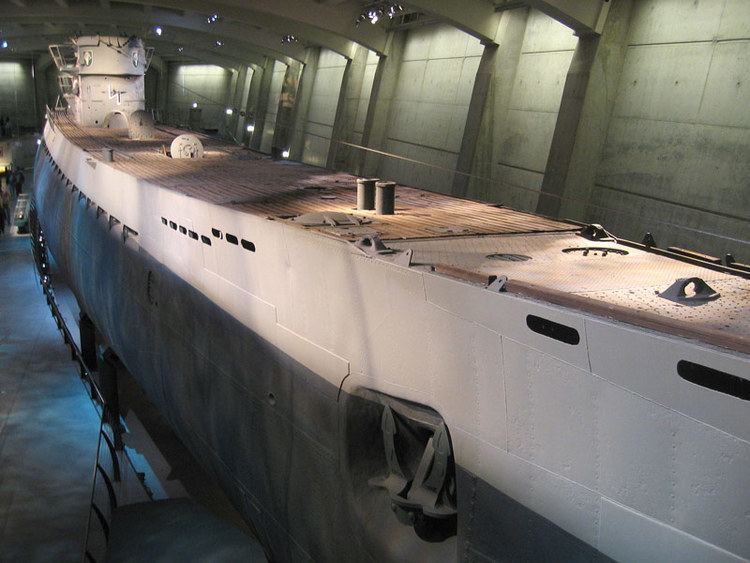Name U-171 Yard number 1011 Commissioned 25 October 1941 Construction started 1 December 1940 Draft 4.7 m | Ordered 23 December 1939 Laid down 1 December 1940 Length 77 m Launched 22 July 1941 Beam 6.76 m | |
 | ||
Part of | ||
German submarine U-171 was a Type IXC U-boat of Nazi Germany's Kriegsmarine built for service during World War II. The submarine was laid down on 1 December 1940 at the DeSchiMAG AG Weser yard at Bremen as yard number 1011; it was launched on 22 July 1941 and commissioned on 25 October 1941 under the command of Kapitänleutnant Günther Pfeffer.
Contents
After training with the 4th U-boat Flotilla, U-171 was transferred to the 10th U-boat Flotilla for front-line service on 1 July 1942. It was sent to patrol in the Gulf of Mexico and was sunk by a naval mine in the Bay of Biscay 115 days into its first, and only patrol whilst returning to Lorient in occupied France, with the loss of 22 of its complement of 54. For many years it was believed that U-166 had been sunk by an American aircraft in what had in reality been an unsuccessful attack on this submarine in the Gulf of Mexico.
Design
German Type IXC submarines were slightly larger than the original Type IXBs. U-171 had a displacement of 1,120 tonnes (1,100 long tons) when at the surface and 1,232 tonnes (1,213 long tons) while submerged. The U-boat had a total length of 76.76 m (251 ft 10 in), a pressure hull length of 58.75 m (192 ft 9 in), a beam of 6.76 m (22 ft 2 in), a height of 9.60 m (31 ft 6 in), and a draught of 4.70 m (15 ft 5 in). The submarine was powered by two MAN M 9 V 40/46 supercharged four-stroke, nine-cylinder diesel engines producing a total of 4,400 metric horsepower (3,240 kW; 4,340 shp) for use while surfaced, two Siemens-Schuckert 2 GU 345/34 double-acting electric motors producing a total of 1,000 metric horsepower (740 kW; 990 shp) for use while submerged. She had two shafts and two 1.92 m (6 ft) propellers. The boat was capable of operating at depths of up to 230 metres (750 ft).
The submarine had a maximum surface speed of 18.3 knots (33.9 km/h; 21.1 mph) and a maximum submerged speed of 7.3 knots (13.5 km/h; 8.4 mph). When submerged, the boat could operate for 63 nautical miles (117 km; 72 mi) at 4 knots (7.4 km/h; 4.6 mph); when surfaced, she could travel 13,450 nautical miles (24,910 km; 15,480 mi) at 10 knots (19 km/h; 12 mph). U-171 was fitted with six 53.3 cm (21 in) torpedo tubes (four fitted at the bow and two at the stern), 22 torpedoes, one 10.5 cm (4.13 in) SK C/32 naval gun, 180 rounds, and a 3.7 cm (1.5 in) as well as a 2 cm (0.79 in) anti-aircraft gun. The boat had a complement of forty-eight.
Patrol
U-171 departed Kiel on 17 June 1942, at the end of which it was to return to Lorient, where it would be based for future sorties. It negotiated the 'gap' between Iceland and the Faroe Islands and crossed the Atlantic Ocean, entering the Gulf of Mexico.
The submarine sank the 4,351-ton Mexican general cargo merchant ship, SS Oaxaca on 26 July 1942, at 28°23′N 96°08′W off Corpus Christi, Texas. The ship was at the time en route from New Orleans to Tampico via Veracruz. The first spread of two torpedoes missed the ship, but a second spread, also of two eels (German U-Boat slang for torpedoes), was successful when one hit the port side near the fore-part of the ship. Six of the crew of 45 died.
On 1 August 1942, also in the Gulf of Mexico, U-171 came under attack from a U.S. Coast Guard J4F-1 Widgeon aircraft, causing it little damage. However, for decades it was believed that the U-boat attacked that day was U-166; the credit for sinking U-166 went to that aircraft.
The wreckage of U-166 was discovered in 2001, just a short distance from its last victim, Robert E. Lee, meaning that the credit for the sinking of U-166 should have gone to the U.S. Navy patrol craft, PC-566, which had reported that they believed they were successful in their depth charge attack on the submarine following the U-boat's successful torpedoing of Robert E. Lee, but PC-566 were believed by investigating officials to have missed.
Having not been sunk, as had been believed by the Allies, U-171 continued its patrol. On 13 August 1942 it sank the 6,779-ton US tanker R. M. Parker Jr. at 28°50′N 90°42′W which is about 25 nmi (46 km; 29 mi) south of Isles Dernieres, Louisiana. The ship, which was carrying water ballast, was struck by two torpedoes; the submarine then surfaced and fired five rounds from its deck gun into the wreck. The whole crew of 44 survived, being picked up eight hours later by the United States Coast Guard auxiliary USS Pioneer (AM-105).
On 4 September 1942, the submarine had its final success, the Mexican tanker Amatlan 6,511 tons; again in ballast, at 23°27′N 97°30′W. This ship had evaded three spreads of two torpedoes each, before being hit by a torpedo fired from U-171's stern tube. There were 10 dead and 24 survivors.
Loss
U-171 was sunk at 13:00 hours on 9 October 1942 in the Bay of Biscay near Lorient, in position 47°39′N 03°34′W, by a mine. Twenty-two men died, thirty survived. Captain Günther Pfeffer (1914–1966), was one of the lucky ones.
The wrecked submarine was classified as a "military cemetery" in 1999 by the French authorities: divers are then warned that going inside the boat is strictly forbidden.
